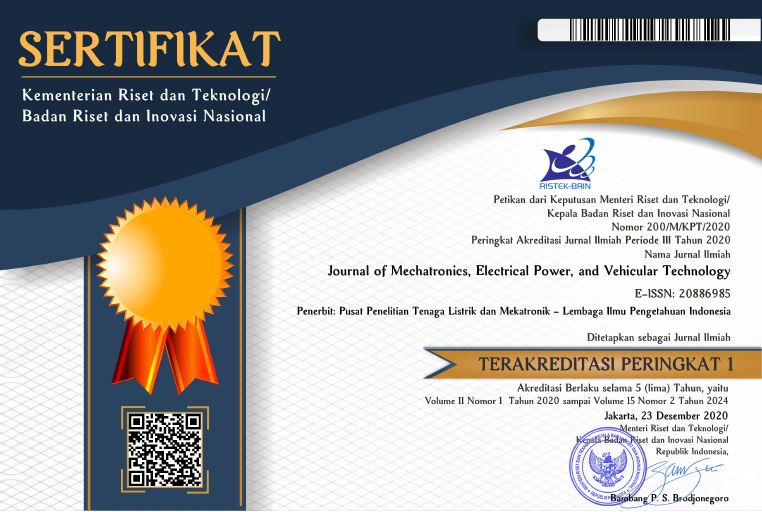Accuracy analysis of geometrical and numerical approaches for two degrees of freedom robot manipulator
Abstract
Keywords
Full Text:
PDFReferences
M. Mirdanies, A. S. Prihatmanto dan E. Rijanto, “Object Recognition System in Remote Controlled Weapon Station using SIFT and SURF Methods,” Mechatronics, Electrical Power, and Vehicular Technology, vol. 4, no. 2, pp. 99-108, 2013. crossref
J. J. Craig, Introduction to Robotics: Mechanics and Control, Third penyunt., Canada: Pearson Prentice Hall, 2005.
H. M. Saputra, Z. Abidin dan E. Rijanto, “Analysis of Inverse Angle Method for Controlling Two Degree of Freedom Manipulator,” Mechatronics, Electrical Power, and Vehicular Technology, vol. 3, no. 1, pp. 9-16, 2012. crossref
H. M. Saputra, “Simulation of 2-DOF Mechanism Control System for Satellite Communication Antennas,” Bandung, 2012.
H. M. Saputra dan E. Rijanto, “Analisis Kinematik dan Dinamik Mekanisme Penggerak 2-DOF untuk Antena Bergerak pada Komunikasi Satelit (Kinematic and dynamic analysis of a 2-DOF mechanism for mobile satellite communication (SATCOM) antennas),” Teknologi Indonesia, vol. 32, pp. 21-29, 2009.
A. Aristidou dan J. Lasenby, “Inverse Kinematics: A Review of Existing Techniques and Introduction of a New Fast Iterative Solver,” 2009.
Y. Feng, W. Yao-Nan dan W. Shu-Ning, “Inverse Kinematic Solution for Robot Manipulator Based on Electromagnetism-like and Modi?ed DFP Algorithms,” Acta Automatica Sinica, vol. 37, no. 1, pp. 74-82, 2011. crossref
K. Tchon, J. Karpinska dan M. Janiak, “Approximation of Jacobian Inverse Kinematics Algorithms,” Int. J. Appl. Math. Comput. Sci, vol. 19, no. 4, pp. 519-531, 2009. crossref
M. Soch dan R. Lorencz, “Solving Inverse Kinematics – A New Approach to the Extended Jacobian Technique,” Acta Polytechnica, vol. 45, no. 2, pp. 21-26, 2005.
R. Taufiq, Perancangan penelitian dan analisis data statistika, Bandung: Penerbit ITB, 2006.
M. C. Anderson, “Generalize Weapon Effectiveness Modeling,” Naval Postgraduate School, Monterey, California, 2004.
R. T. Jorris dan B. M. Young, “Design of Experiments and Analysis Examples from USAF Test Pilot School,” dalam U.S. Air Force T&E Days 2010, Nashville, Tennessee, 2010.
C. McMillan dan P. McMillan, “Characterizing ri?e performance using circular error probable measured via a ?atbed scanner,” dalam Version 1.01 ed: Creative Commons Attribution-Noncommercial-No Derivative Works 3.0 United States License, 2008.
Y. Wang, G. Yang, D. Yan, Y. Wang dan X. Song, “Comprehensive Assessment Algorithm for Calculating CEP of Positioning Accuracy,” Measurement, vol. 47, pp. 255-263, 2014. crossref
A. Didonato, “Computation of the Circular Error Probable (CEP) and Confidence Intervals in Bombing Test,” Dahlgren Division Naval Surface Warfare Center NSWCDD/TR-07/13, Dahlgren, Virginia, 2007.
Article Metrics
Metrics powered by PLOS ALM
Refbacks
- There are currently no refbacks.
Copyright (c) 2016 Journal of Mechatronics, Electrical Power, and Vehicular Technology

This work is licensed under a Creative Commons Attribution-NonCommercial-ShareAlike 4.0 International License.




















